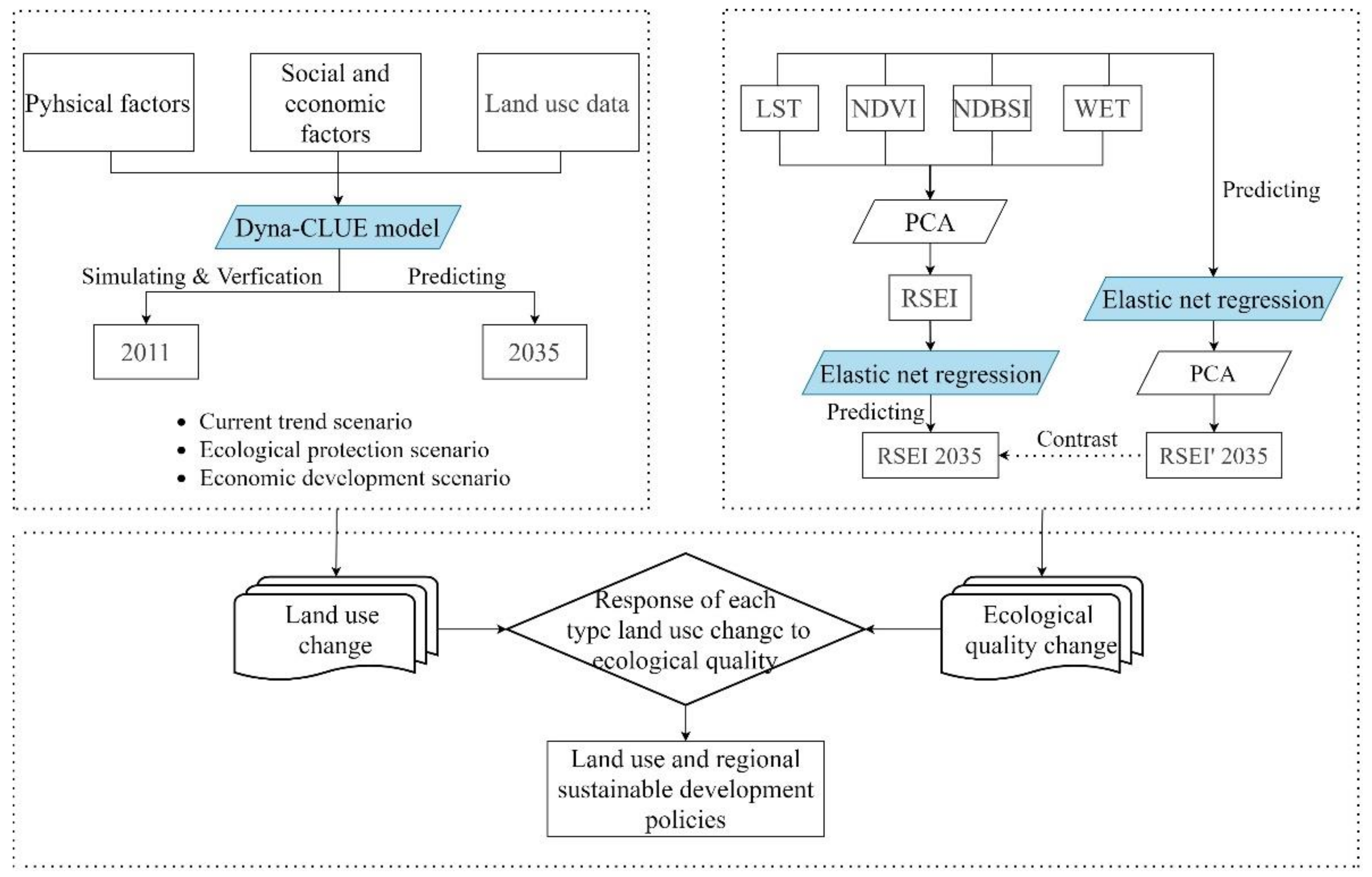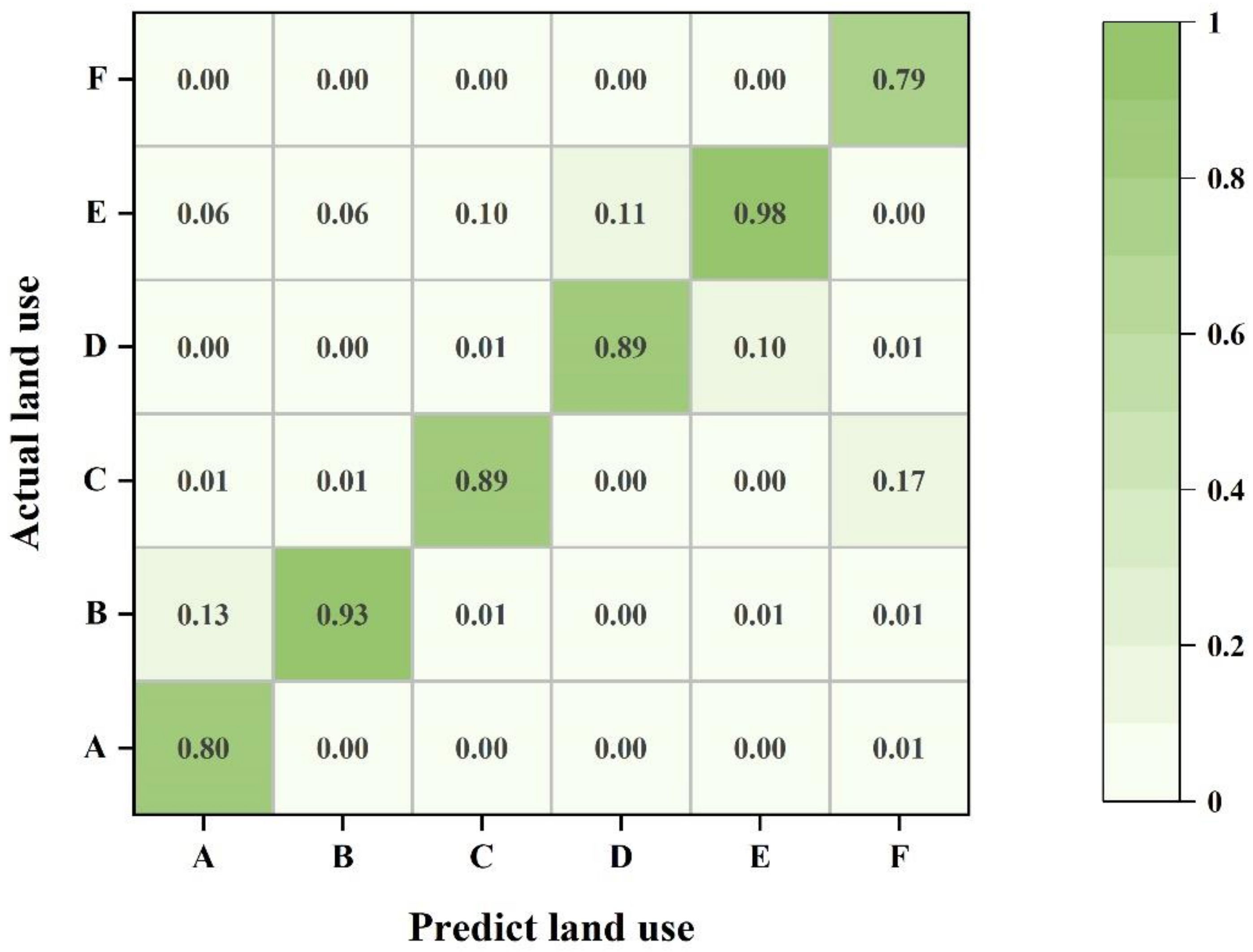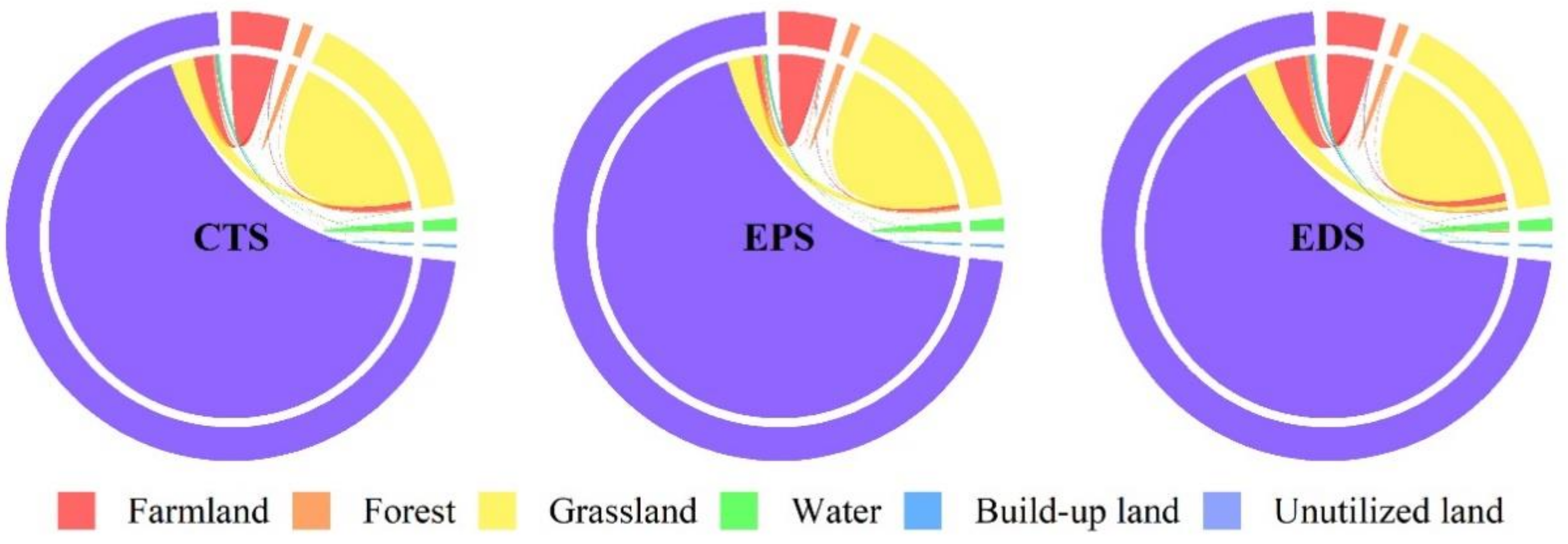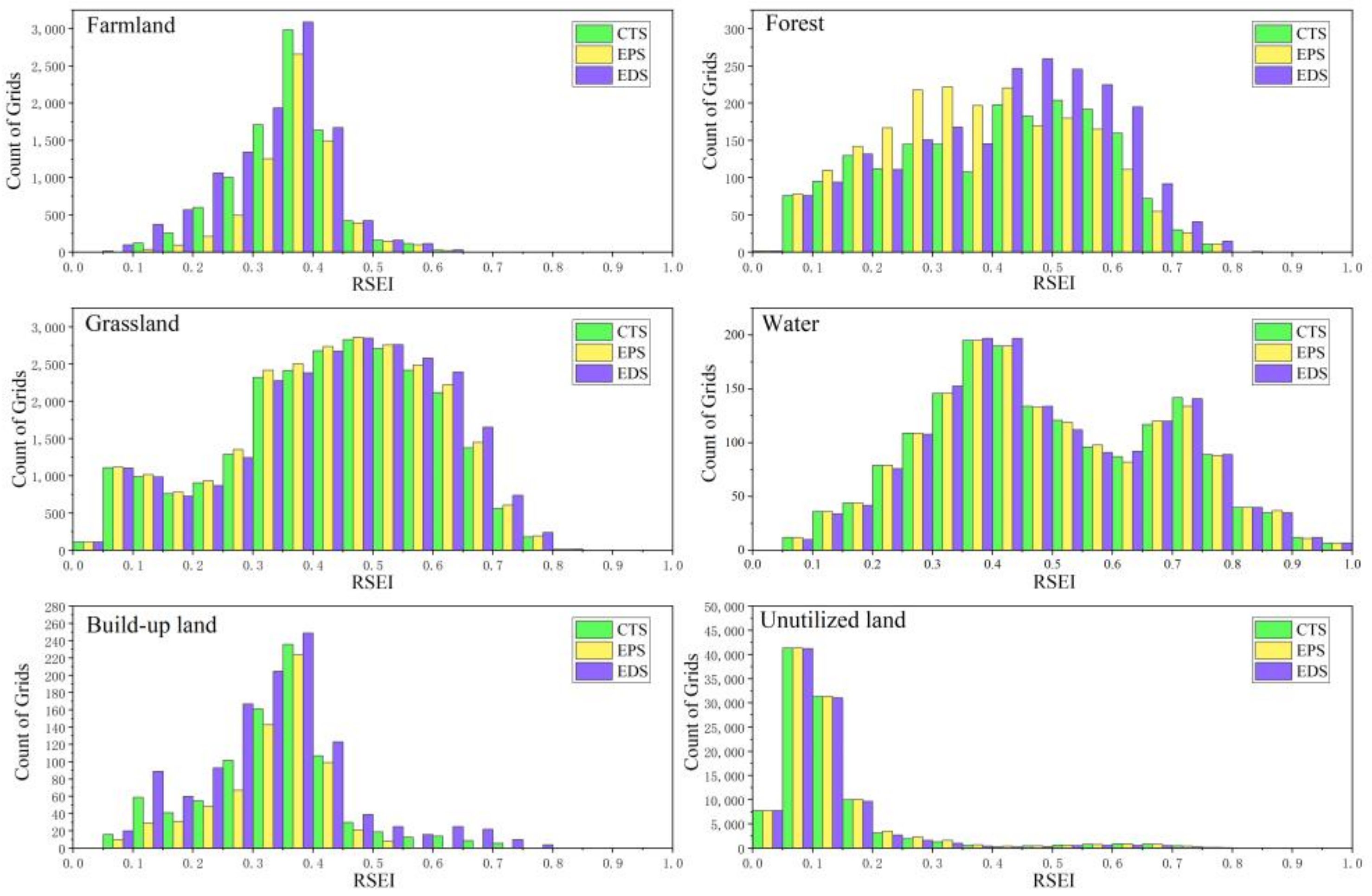Ecological Quality Response to Multi-Scenario Land-Use Changes in the Heihe River Basin
Abstract
:1. Introduction
2. Materials and Methods
2.1. Study Area
2.2. An Integration Framework for Predicting Land Use and Ecological Quality
2.3. Data
2.4. Scenarios Analysis
2.5. Land-Use Model
2.6. Calculation of RSEI
2.7. Validation
3. Results
3.1. Projected Land-Use Changes
3.2. RSEI Prediction Results
3.3. Ecological Correspondence of Different Land-Use Scenarios
4. Discussion
4.1. Spatial Impact of Land-Use Changes on Ecological Quality
4.2. Ecological Quality of the Response to Multi-scenario Land-Use Changes
4.3. Policies Responding to Prediction Results
4.4. Advantage and Disadvantage of the Integration Framework
5. Conclusions
Author Contributions
Funding
Institutional Review Board Statement
Informed Consent Statement
Data Availability Statement
Acknowledgments
Conflicts of Interest
References
- Borrelli, P.; Robinson, D.A.; Panagos, P.; Lugato, E.; Yang, J.E.; Alewell, C.; Wuepper, D.; Montanarella, L.; Ballabio, C. Land use and climate change impacts on global soil erosion by water (2015–2070). Proc. Natl. Acad. Sci. USA 2020, 117, 21994–22001. [Google Scholar] [CrossRef]
- Robinson, D.A.; Panagos, P.; Borrelli, P.; Jones, A.; Montanarella, L.; Tye, A.; Obst, C.G. Soil natural capital in europe; a framework for state and change assessment. Sci. Rep. 2017, 7, 6706. [Google Scholar] [CrossRef] [Green Version]
- Shen, Q.; Gao, G.; Han, F.; Xiao, F.; Ma, Y.; Wang, S.; Fu, B. Quantifying the effects of human activities and climate variability on vegetation cover change in a hyper-arid endorheic basin. Land Degrad. Dev. 2018, 29, 3294–3304. [Google Scholar] [CrossRef]
- Winkler, K.; Fuchs, R.; Rounsevell, M.; Herold, M. Global land use changes are four times greater than previously estimated. Nat. Commun. 2021, 12, 2501. [Google Scholar] [CrossRef] [PubMed]
- Morton, D.C.; DeFries, R.S.; Shimabukuro, Y.E.; Anderson, L.O.; Arai, E.; del Bon Espirito-Santo, F.; Freitas, R.; Morisette, J. Cropland expansion changes deforestation dynamics in the southern brazilian amazon. Proc. Natl. Acad. Sci. USA 2006, 103, 14637–14641. [Google Scholar] [CrossRef] [PubMed] [Green Version]
- Macedo, M.N.; DeFries, R.S.; Morton, D.C.; Stickler, C.M.; Galford, G.L.; Shimabukuro, Y.E. Decoupling of deforestation and soy production in the southern amazon during the late 2000s. Proc. Natl. Acad. Sci. USA 2012, 109, 1341–1346. [Google Scholar] [CrossRef] [Green Version]
- Perz, S.G.; Qiu, Y.; Xia, Y.; Southworth, J.; Sun, J.; Marsik, M.; Rocha, K.; Passos, V.; Rojas, D.; Alarcón, G.; et al. Trans-boundary infrastructure and land cover change: Highway paving and community-level deforestation in a tri-national frontier in the amazon. Land Use Policy 2013, 34, 27–41. [Google Scholar] [CrossRef]
- Montoya, A.; de Lima, A.; Adami, M. Analysis of the land cover around a hydroelectric power plant in the brazilian amazon. Anu. Inst. Geociênc 2019, 42, 74–86. [Google Scholar] [CrossRef]
- Xu, X.; Xie, Y.; Qi, K.; Luo, Z.; Wang, X. Detecting the response of bird communities and biodiversity to habitat loss and fragmentation due to urbanization. Sci. Total Environ. 2018, 624, 1561–1576. [Google Scholar] [CrossRef]
- Llerena-Montoya, S.; Velastegui-Montoya, A.; Zhirzhan-Azanza, B.; Herrera-Matamoros, V.; Adami, M.; de Lima, A.; Moscoso-Silva, F.; Encalada, L. Multitemporal analysis of land use and land cover within an oil block in the ecuadorian amazon. ISPRS Int. J. Geo-Inf. 2021, 10, 191. [Google Scholar] [CrossRef]
- Kamusoko, C.; Aniya, M.; Adi, B.; Manjoro, M. Rural sustainability under threat in zimbabwe–simulation of future land use/cover changes in the bindura district based on the markov-cellular automata model. Appl. Geogr. 2009, 29, 435–447. [Google Scholar] [CrossRef]
- Sang, L.; Zhang, C.; Yang, J.; Zhu, D.; Yun, W. Simulation of land use spatial pattern of towns and villages based on ca–markov model. Math. Comput. Model. 2011, 54, 938–943. [Google Scholar] [CrossRef]
- Subedi, P.; Subedi, K.; Thapa, B. Application of a hybrid cellular automaton–markov (ca-markov) model in land-use change prediction: A case study of saddle creek drainage basin, florida. Appl. Ecol. Environ. Sci. 2013, 1, 126–132. [Google Scholar] [CrossRef] [Green Version]
- Behera, M.D.; Borate, S.N.; Panda, S.N.; Behera, P.R.; Roy, P.S. Modelling and analyzing the watershed dynamics using cellular automata (ca)–markov model–a geo-information based approach. J. Earth Syst. Sci. 2012, 121, 1011–1024. [Google Scholar] [CrossRef] [Green Version]
- Nouri, J.; Gharagozlou, A.; Arjmandi, R.; Faryadi, S.; Adl, M. Predicting urban land use changes using a ca–markov model. Arab. J. Sci. Eng. 2014, 39, 5565–5573. [Google Scholar] [CrossRef]
- Mansour, S.; Al-Belushi, M.; Al-Awadhi, T. Monitoring land use and land cover changes in the mountainous cities of oman using gis and ca-markov modelling techniques. Land Use Policy 2020, 91, 104414. [Google Scholar] [CrossRef]
- Verburg, P.H.; Soepboer, W.; Veldkamp, A.; Limpiada, R.; Espaldon, V.; Mastura, S.S. Modeling the spatial dynamics of regional land use: The clue-s model. Environ. Manag. 2002, 30, 391–405. [Google Scholar] [CrossRef]
- Verburg, P.H.; Veldkamp, A. Projecting land use transitions at forest fringes in the philippines at two spatial scales. Landsc. Ecol. 2004, 19, 77–98. [Google Scholar] [CrossRef]
- Verburg, P.H.; Overmars, K.P. Combining top-down and bottom-up dynamics in land use modeling: Exploring the future of abandoned farmlands in europe with the dyna-clue model. Landsc. Ecol. 2009, 24, 1167–1181. [Google Scholar] [CrossRef]
- Lima, M.L.; Zelaya, K.; Massone, H. Groundwater vulnerability assessment combining the drastic and dyna-clue model in the argentine pampas. Environ. Manag. 2011, 47, 828–839. [Google Scholar] [CrossRef]
- Sakayarote, K.; Shrestha, R.P. Simulating land use for protecting food crop areas in northeast thailand using gis and dyna-clue. J. Geogr. Sci. 2019, 29, 803–817. [Google Scholar] [CrossRef] [Green Version]
- Waiyasusri, K.; Wetchayont, P. Assessing long-term deforestation in nam san watershed, loei province, thailand using a dyna-clue model. Geogr. Environ. Sustain. 2020, 13, 81–97. [Google Scholar] [CrossRef]
- Wang, Y.; Chao, B.; Dong, P.; Zhang, D.; Yu, W.; Hu, W.; Ma, Z.; Chen, G.; Liu, Z.; Chen, B. Simulating spatial change of mangrove habitat under the impact of coastal land use: Coupling maxent and dyna-clue models. Sci. Total Environ. 2021, 788, 147914. [Google Scholar] [CrossRef] [PubMed]
- Liu, J.; Zhang, Z.; Xu, X.; Kuang, W.; Zhou, W.; Zhang, S.; Li, R.; Yan, C.; Yu, D.; Wu, S.; et al. Spatial patterns and driving forces of land use change in china during the early 21st century. J. Geogr. Sci. 2010, 20, 483–494. [Google Scholar] [CrossRef]
- De Keersmaecker, W.; Lhermitte, S.; Honnay, O.; Farifteh, J.; Somers, B.; Coppin, P. How to measure ecosystem stability? An evaluation of the reliability of stability metrics based on remote sensing time series across the major global ecosystems. Glob. Change Biol. 2014, 20, 2149–2161. [Google Scholar] [CrossRef] [PubMed]
- Xu, H. A remote sensing urban ecological index and its application. Acta Ecol. Sin. 2013, 33, 7853–7862. [Google Scholar] [CrossRef]
- Xu, H. Remote sensing evaluation index of regional ecological environment change. China Environ. Sci. 2013, 33, 889–897. [Google Scholar]
- Xu, H.; Wang, M.; Shi, T.; Guan, H.; Fang, C.; Lin, Z. Prediction of ecological effects of potential population and impervious surface increases using a remote sensing based ecological index (rsei). Ecol. Indic. 2018, 93, 730–740. [Google Scholar] [CrossRef]
- Yuan, B.; Fu, L.; Zou, Y.; Zhang, S.; Chen, X.; Li, F.; Deng, Z.; Xie, Y. Spatiotemporal change detection of ecological quality and the associated affecting factors in dongting lake basin, based on rsei. J. Clean. Prod. 2021, 302, 126995. [Google Scholar] [CrossRef]
- Xiong, Y.; Xu, W.; Lu, N.; Huang, S.; Wu, C.; Wang, L.; Dai, F.; Kou, W. Assessment of spatial–temporal changes of ecological environment quality based on rsei and gee: A case study in erhai lake basin, yunnan province, china. Ecol. Indic. 2021, 125, 107518. [Google Scholar] [CrossRef]
- Zhu, D.; Chen, T.; Zhen, N.; Niu, R. Monitoring the effects of open-pit mining on the eco-environment using a moving window-based remote sensing ecological index. Environ. Sci. Pollut. Res. 2020, 27, 15716–15728. [Google Scholar] [CrossRef] [PubMed]
- Hu, X.; Xu, H. A new remote sensing index for assessing the spatial heterogeneity in urban ecological quality: A case from fuzhou city, china. Ecol. Indic. 2018, 89, 11–21. [Google Scholar] [CrossRef]
- Gou, R.; Zhao, J. Eco-environmental quality monitoring in beijing, china, using an rsei-based approach combined with random forest algorithms. IEEE Access 2020, 8, 196657–196666. [Google Scholar] [CrossRef]
- Ariken, M.; Zhang, F.; Liu, K.; Fang, C.; Kung, H.-T. Coupling coordination analysis of urbanization and eco-environment in yanqi basin based on multi-source remote sensing data. Ecol. Indic. 2020, 114, 106331. [Google Scholar] [CrossRef]
- Yang, H.; Zhong, X.; Deng, S.; Xu, H. Assessment of the impact of lucc on npp and its influencing factors in the yangtze river basin, china. CATENA 2021, 206, 105542. [Google Scholar] [CrossRef]
- Hou, K.; Wen, J. Quantitative analysis of the relationship between land use and urbanization development in typical arid areas. Environ. Sci. Pollut. Res. 2020, 27, 38758–38768. [Google Scholar] [CrossRef]
- Wang, J.; Liu, Y.; Li, Y. Ecological restoration under rural restructuring: A case study of yan’an in china’s loess plateau. Land Use Policy 2019, 87, 104087. [Google Scholar] [CrossRef]
- Xiao, S.; Xiao, H. The impact of human activity on the water environment of heihe water basin in last century. J. Arid Land Resour. Environ. 2004, 18, 57–62. [Google Scholar] [CrossRef]
- Zhang, M.; Wang, S.; Fu, B.; Gao, G.; Shen, Q. Ecological effects and potential risks of the water diversion project in the heihe river basin. Sci. Total Environ. 2018, 619-620, 794–803. [Google Scholar] [CrossRef]
- Wang, F.; Pan, X.; Wang, D.; Shen, C.; Lu, Q. Combating desertification in china: Past, present and future. Land Use Policy 2013, 31, 311–313. [Google Scholar] [CrossRef]
- Wang, X.M.; Zhang, C.X.; Hasi, E.; Dong, Z.B. Has the three norths forest shelterbelt program solved the desertification and dust storm problems in arid and semiarid china? J. Arid Environ. 2010, 74, 13–22. [Google Scholar] [CrossRef]
- Yin, H.; Pflugmacher, D.; Li, A.; Li, Z.; Hostert, P. Land use and land cover change in inner mongolia—Understanding the effects of china’s re-vegetation programs. Remote Sens. Environ. 2018, 204, 918–930. [Google Scholar] [CrossRef]
- Li, X.; Cheng, G.; Liu, S.; Xiao, Q.; Ma, M.; Jin, R.; Che, T.; Liu, Q.; Wang, W.; Qi, Y. Heihe watershed allied telemetry experimental research (hiwater): Scientific objectives and experimental design. Bull. Am. Meteorol. Soc. 2013, 94, 1145–1160. [Google Scholar] [CrossRef]
- Ge, Y.; Li, X.; Tian, W.; Zhang, Y.; Wang, W.; Hu, X. The impacts of water delivery on artificial hydrological circulation system of the middle reaches of the heihe river basin. Adv. Earth Sci. 2014, 29, 285. [Google Scholar] [CrossRef]
- Li, X.; Cheng, G.; Ge, Y.; Li, H.; Han, F.; Hu, X.; Tian, W.; Tian, Y.; Pan, X.; Nian, Y. Hydrological cycle in the heihe river basin and its implication for water resource management in endorheic basins. J. Geophys. Res. Atmos. 2018, 123, 890–914. [Google Scholar] [CrossRef]
- Jianhua, W. Landuse/Landcover Data of the Heihe River Basin in 2000; National Tibetan Plateau Data Center: Beijing, China, 2015. [Google Scholar] [CrossRef]
- Hu, X.; Lu, L.; Li, X.; Wang, J.; Guo, M. Land use/cover change in the middle reaches of the heihe river basin over 2000–2011 and its implications for sustainable water resource management. PLoS ONE 2015, 10, e0128960. [Google Scholar] [CrossRef]
- Jianhua, W. Landuse/Landcover Data of the Heihe River Basin (2011); National Tibetan Plateau Data Center: Beijing, China, 2014. [Google Scholar] [CrossRef]
- National Basic Geographic Information Center. 1km Dem Dataset in the Heihe River Basin (2011); National Tibetan Plateau Data Center: Beijing, China, 2013. [Google Scholar]
- Na, Z.; Tianxiang, Y. Monthly Mean Temperature for the Period (1961–2010); National Tibetan Plateau Data Center: Beijing, China, 2016. [Google Scholar] [CrossRef]
- Zhao, N.; Yue, T.; Zhou, X.; Zhao, M.; Liu, Y.; Du, Z.; Zhang, L. Statistical downscaling of precipitation using local regression and high accuracy surface modeling method. Theor. Appl. Climatol. 2017, 129, 281–292. [Google Scholar] [CrossRef]
- Tianxiang, Y.; Na, Z. Monthly Mean Vegetation Index and Precipitation Data Set of Heihe River Basin (1961–2010); National Tibetan Plateau Data Center: Beijing, China, 2018. [Google Scholar] [CrossRef]
- National Basic Geographic Information Center. Iver Network Dataset of the Heihe River Basin (2009); National Tibetan Plateau Data Center: Beijing, China, 2013. [Google Scholar]
- Li, X.; Nan, Z.; Cheng, G.; Ding, Y.; Wu, L.; Wang, L.; Wang, J.; Ran, Y.; Li, H.; Pan, X. Toward an improved data stewardship and service for environmental and ecological science data in west china. Int. J. Digit. Earth 2011, 4, 347–359. [Google Scholar] [CrossRef]
- Jun, Z. Dataset of the Heihe Social Economy (2000–2009); National Tibetan Plateau Data Center: Beijing, China, 2013. [Google Scholar]
- Lizong, W.; Yanyun, N. Primary Road Network Dataset of the Heihe River Basin (2010); National Tibetan Plateau Data Center: Beijing, China, 2013. [Google Scholar]
- National Basic Geographic Information Center. The Resident Site Distribution Data of the Heihe River Basin; National Tibetan Plateau Data Center: Beijing, China, 2013. [Google Scholar]
- Xuemei, W.; Mingguo, M. Gridded Population Data of the Heihe River Basin (2000); National Tibetan Plateau Data Center: Beijing, China, 2013. [Google Scholar] [CrossRef]
- Wang, X.; Ma, M. A distance variable to simulate the urban population. In Remote Sensing for Environmental Monitoring, GIS Applications, and Geology VII; International Society for Optics and Photonics: Bellingham, WA, USA, 2007; p. 67491S. [Google Scholar] [CrossRef]
- Krisnayanti, D.S.; Bunganaen, W.; Frans, J.; Seran, Y.A.; Legono, D. Curve number estimation for ungauged watershed in semi-arid region. Civ. Eng. J. 2021, 7, 1070–1083. [Google Scholar] [CrossRef]
- Feistel, R.; Hellmuth, O. Relative humidity: A control valve of the steam engine climate. J. Hum. Earth Future 2021, 2, 140–182. [Google Scholar] [CrossRef]
- Ekwueme, B.N.; Agunwamba, J.C. Trend analysis and variability of air temperature and rainfall in regional river basins. Civ. Eng. J. 2021, 7. [Google Scholar] [CrossRef]
- Chuanglin, F.; Chao, B. The coupling model of water-ecology-economy coordinated development and its application in heihe river basin. Acta Geogr. Sin. 2004, 59, 781–790. [Google Scholar] [CrossRef]
- Ling, Z. Multiple-Scenario Analyses of Land Use Change and Hydrological Responses in the Heihe River Basin. Master’s Thesis, University of Chinese Academy of Sciences, Beijing, China, 2014. [Google Scholar]
- Lin, Y.-P.; Chu, H.-J.; Wu, C.-F.; Verburg, P.H. Predictive ability of logistic regression, auto-logistic regression and neural network models in empirical land-use change modeling—A case study. Int. J. Geogr. Inf. Sci. 2011, 25, 65–87. [Google Scholar] [CrossRef] [Green Version]
- Pontius, R.G.; Schneider, L.C. Land-cover change model validation by an roc method for the ipswich watershed, massachusetts, USA. Agric. Ecosyst. Environ. 2001, 85, 239–248. [Google Scholar] [CrossRef]
- Pontius, R.G. Quantification error versus location error in comparison of categorical maps. Photogramm. Eng. Remote Sens. 2000, 66, 1011–1016. [Google Scholar]
- Congalton, R.G. A review of assessing the accuracy of classifications of remotely sensed data. Remote Sens. Environ. 1991, 37, 35–46. [Google Scholar] [CrossRef]
- Foody, G.M. Status of land cover classification accuracy assessment. Remote Sens. Environ. 2002, 80, 185–201. [Google Scholar] [CrossRef]
- Liao, W.; Jiang, W. Evaluation of the spatiotemporal variations in the eco-environmental quality in china based on the remote sensing ecological index. Remote Sens. 2020, 12, 2462. [Google Scholar] [CrossRef]
- Xu, H.; Wang, Y.; Guan, H.; Shi, T.; Hu, X. Detecting ecological changes with a remote sensing based ecological index (rsei) produced time series and change vector analysis. Remote Sens. 2019, 11, 2345. [Google Scholar] [CrossRef] [Green Version]
- Lobser, S.; Cohen, W. Modis tasselled cap: Land cover characteristics expressed through transformed modis data. Int. J. Remote Sens. 2007, 28, 5079–5101. [Google Scholar] [CrossRef]
- Park, I.W.; Mazer, S.J. Overlooked climate parameters best predict flowering onset: Assessing phenological models using the elastic net. Glob. Change Biol. 2018, 24, 5972–5984. [Google Scholar] [CrossRef] [PubMed]
- Zou, H.; Hastie, T. Regularization and variable selection via the elastic net. J. R. Stat. Soc. Ser. B 2005, 67, 301–320. [Google Scholar] [CrossRef] [Green Version]
- Raposo, M.; Quinto-Canas, R.; Cano-Ortiz, A.; Spampinato, G.; Pinto Gomes, C. Originalities of willow of salix atrocinerea brot. In mediterranean europe. Sustainability 2020, 12, 8019. [Google Scholar] [CrossRef]
- Shirmohammadi, B.; Malekian, A.; Salajegheh, A.; Taheri, B.; Azarnivand, H.; Malek, Z.; Verburg, P.H. Scenario analysis for integrated water resources management under future land use change in the urmia lake region, iran. Land Use Policy 2020, 90, 104299. [Google Scholar] [CrossRef]
- Wang, X.; Zheng, D.; Shen, Y. Land use change and its driving forces on the tibetan plateau during 1990–2000. CATENA 2008, 72, 56–66. [Google Scholar] [CrossRef]
- Song, H.M.; Xue, L. Dynamic monitoring and analysis of ecological environment in weinan city, northwest china based on rsei model. Ying Yong Sheng Tai Xue Bao 2016, 27, 3913–3919. [Google Scholar] [CrossRef]








| Data Type | Modeling Input Raster Data | Resolution | Data Sources |
|---|---|---|---|
| Base data | Land use data2000 | - | National Tibetan Plateau Third Pole Environment Data Center (https://data.tpdc.ac.cn/en/data/320690e1-f8aa-4c51-a189-4c82f7e64b39/ (accessed on 7 July 2020)) [46,47] |
| Land use data2011 | - | National Tibetan Plateau Third Pole Environment Data Center (https://data.tpdc.ac.cn/en/data/b7ec37e6-339d-4777-80d3-bab18e6b7519/ (accessed on 7 July 2020)) [47,48] | |
| Natural factors | DEM | 1 km | National Tibetan Plateau Third Pole Environment Data Center (https://data.tpdc.ac.cn/en/data/d6776cbb-7bdc-4838-b361-389f43e241e1/ (accessed on 9 September 2020)) [49] |
| Slope | 1 km | National Tibetan Plateau Third Pole Environment Data Center (https://data.tpdc.ac.cn/en/data/d6776cbb-7bdc-4838-b361-389f43e241e1/ (accessed on 9 September 2020)) | |
| Temperature | 500 m | National Tibetan Plateau Third Pole Environment Data Center (https://data.tpdc.ac.cn/en/data/54d6c2f2-e499-456e-88ed-f044ea034c3c/ (accessed on 2 March 2021)) [50,51] | |
| Precipitation | 500 m | National Tibetan Plateau Third Pole Environment Data Center (https://data.tpdc.ac.cn/en/data/8c00784a-f02a-49a3-b611-578cc62b0ede/ (accessed on 2 March 2021)) [52] | |
| Distance to river | - | National Tibetan Plateau Third Pole Environment Data Center (https://data.tpdc.ac.cn/en/data/7e10801a-7f23-4760-8b74-a284dabf78a0/ (accessed on 7 January 2021)) [53,54] | |
| Economic factors | GDP | - | National Tibetan Plateau Third Pole Environment Data Center (https://data.tpdc.ac.cn/en/data/b18a2fb8-95fe-4ac4-b788-be88c0b6ec4a/ (accessed on 2 March 2021)) [55] |
| Social factors | Distance to highway | - | National Tibetan Plateau Third Pole Environment Data Center (https://data.tpdc.ac.cn/en/data/2cbd15cf-0591-41f2-a8d7-c4b8a232337c/ (accessed on 2 March 2021)) [54,56] |
| Distance to road | - | National Tibetan Plateau Third Pole Environment Data Center (https://data.tpdc.ac.cn/en/data/2cbd15cf-0591-41f2-a8d7-c4b8a232337c/ (accessed on 2 March 2021)) | |
| Distance to settlements | - | National Tibetan Plateau Third Pole Environment Data Center (https://data.tpdc.ac.cn/en/data/37bb0731-48fe-429b-8f09-6cc8dbac1f03/ (accessed on 2 March 2021)) [54,57] | |
| Population | 1 km | National Tibetan Plateau Third Pole Environment Data Center (https://data.tpdc.ac.cn/en/data/032a5c57-df08-42ab-954e-218ef71cc28b/ (accessed on 21 September 2020)) [58,59] |
| Index | 2000 PC1 | 2003 PC1 | 2006 PC1 | 2009 PC1 | 2012 PC1 | 2015 PC1 | 2017 PC1 | 2020 PC1 |
|---|---|---|---|---|---|---|---|---|
| NDVI | −0.343 | −0.327 | −0.356 | −0.381 | −0.321 | −0.284 | −0.329 | −0.337 |
| Wet | −0.380 | −0.379 | −0.378 | −0.333 | −0.386 | −0.413 | −0.390 | −0.419 |
| LST | 0.620 | 0.635 | 0.652 | 0.694 | 0.614 | 0.582 | 0.629 | 0.557 |
| NDBSI | 0.594 | 0.635 | 0.553 | 0.513 | 0.609 | 0.640 | 0.587 | 0.633 |
| Eigen proportions (%) | 84.42 | 83.89 | 79.46 | 78.21 | 85.34 | 86.36 | 85.15 | 83.63 |
| 2000 | 2011 | 2035CTS | 2035EPS | 2035EDS | |
|---|---|---|---|---|---|
| Farmland (ha) | 619,300 | 709,400 | 905,981.82 | 689,248.76 | 1,088,336.36 |
| Forest (ha) | 127,700 | 146,500 | 187,518.18 | 207,450.37 | 220,245.45 |
| Grassland (ha) | 2,355,900 | 2,394,400 | 2,478,400 | 2,558,205.49 | 2,562,200 |
| Water (ha) | 156,000 | 160,200 | 169,363.64 | 169,363.64 | 169,363.64 |
| Build-up land (ha) | 36,200 | 52,400 | 87,745.45 | 70,072.73 | 115,654.55 |
| Unutilized land (ha) | 10,763,800 | 10,596,000 | 10,229,890.91 | 10,364,559.02 | 9,903,100 |
| Total (ha) | 14,058,900 | 14,058,900 | 14,058,900 | 14,058,900 | 14,058,900 |
Publisher’s Note: MDPI stays neutral with regard to jurisdictional claims in published maps and institutional affiliations. |
© 2022 by the authors. Licensee MDPI, Basel, Switzerland. This article is an open access article distributed under the terms and conditions of the Creative Commons Attribution (CC BY) license (https://creativecommons.org/licenses/by/4.0/).
Share and Cite
Wang, S.; Ge, Y. Ecological Quality Response to Multi-Scenario Land-Use Changes in the Heihe River Basin. Sustainability 2022, 14, 2716. https://doi.org/10.3390/su14052716
Wang S, Ge Y. Ecological Quality Response to Multi-Scenario Land-Use Changes in the Heihe River Basin. Sustainability. 2022; 14(5):2716. https://doi.org/10.3390/su14052716
Chicago/Turabian StyleWang, Shengtang, and Yingchun Ge. 2022. "Ecological Quality Response to Multi-Scenario Land-Use Changes in the Heihe River Basin" Sustainability 14, no. 5: 2716. https://doi.org/10.3390/su14052716






